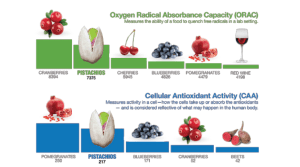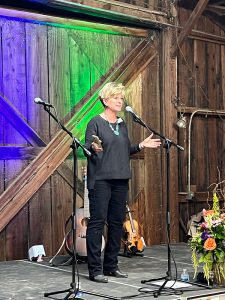
When you think of foods high in antioxidants, which foods come to mind? Blueberries, pomegranates or red wine? You’d be right on all of those. Now, thanks to a new study by Cornell University and published in the scientific journal Nutrients, you can add American-grown pistachios to that list. In fact, pistachios rival all those foods in their antioxidant levels. This will be shocking news to those who assumed all foods high in antioxidants are deep red, purple or orange in color. Apparently, green is the new gold standard.
“As if we didn’t have enough good news about the health benefits of pistachios, this is one of the most exciting studies to come out of a university,” said Judy Hirigoyen, VP of Global Marketing for American Pistachio Growers (APG), the organization that funded the study. “Consumers know they need protein, and they need antioxidants. Pistachios deliver both, conveniently and deliciously.”
In March 2020, Dr. Mehmet Oz announced the findings that pistachios are a complete protein, meaning they contain all nine essential amino acids that are normally found in animal proteins like meat, fish, poultry, dairy and eggs. APG made this their singular focus for promotion in all international markets, just as consumers, and governments, are encouraging the intake of more plant-based proteins. In a recent survey of professional dietitians in Europe, it was found that 50% are now aware of the complete protein in pistachios. In the same survey, an increased number of dietitians also reported they recommend pistachios as part of a healthy diet. The findings were compared to a baseline survey conducted in 2016.

“That’s why APG exists, to discover the benefits of American pistachios and publicize those benefits around the world. Although pistachios have been part of food cultures in many countries, knowledge of their health benefits are relatively new thanks to APG members who are funding credible research,” said Amber Wilson, R.D., who is Director of Nutrition Research and Communication at APG.
When asked if the research would continue if APG didn’t fund it, Hirigoyen responded, “It would come to a screeching halt. Universities rely on grants to do most all their research in any field. In the minds of consumers, pistachios would be aligned with low-value products in the snack aisle.”

The proof is in the pistachio pudding, according to Hirigoyen. She cites international trade data that points to increases in shipments and consumption in key export markets thanks to increased awareness of American pistachios.
Now, Hirigoyen and Wilson are leading the global effort to publicize the new antioxidant findings. “We’re putting everything into antioxidant messaging now,” said Hirigoyen. “A year from now, when consumers and dietitians are asked which foods are high in antioxidants, we want them to say blueberries, pomegranates, red wine and,” adding with a grin, “pistachios.”















